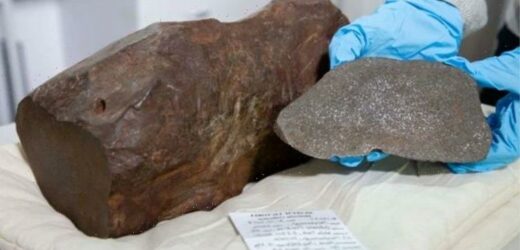Turkey: 'Fireball' meteor lights up the sky as it falls
We use your sign-up to provide content in ways you’ve consented to and to improve our understanding of you. This may include adverts from us and 3rd parties based on our understanding. You can unsubscribe at any time. More info
David Hole stumbled across a reddish, heavy rock in yellow clay as he combed Maryborough Regional Park, close to Melbourne in 2015. The famous Australian gold rush washed over the area in the nineteenth century.
With this in mind, Mr Hole took home his find, convinced it contained a gold nugget.
Despite his best efforts, the rock could not be split open to reveal its contents, and after years of mystery, Mr Hole found out that he had found a rare meteorite after taking it to the Melbourne Museum.
Dermot Henry, geologist for the museum, described how in his 37 years of working in the area, he had only come across two genuine meteroites.
Speaking to Channel 10 News, Mr Henry commented: “I’ve looked at a lot of rocks that people think are meteorites.”


Mr Henry told The Sydney Morning Herald: “It had this sculpted, dimpled look to it.
“That’s formed when they come through the atmosphere.
“They are melting on the outside, and the atmosphere sculpts them.”
Fellow geologist Dr Bill Birch added: “If you saw a rock on earth like this, and you picked it up, it shouldn’t be that heavy.”


Speaking of its scientific value, Mr Henry said: “Meteorites provide the cheapest form of space exploration.
“They transport us back in time, providing clues to the age, formation and chemistry of our Solar System.”
He continued: “Some provide a glimpse at the deep interior of our planet.
“In some meteorites, there is ‘stardust’ even older than our Solar System, which shows us how stars form and evolve to create elements of the periodic table.
DON’T MISS:
Tory rebellion LIVE: Revolt brews TODAY – MPs outraged at £900m tax [LIVE]
Royal POLL: Should Queen, Charles and William boycott the BBC? VOTE [POLL]
House prices: North-South price divide ‘turned on its head’ [INSIGHT]

“Other rare meteorites contain organic molecules such as amino acids; the building blocks of life.”
He predicted: “This particular meteorite most probably comes out of the asteroid belt between Mars and Jupiter, and it’s been nudged out of there by some asteroids smashing into each other, then one day it smashes into Earth.”
Researchers estimate the meteorite to be around 4.6 billion years old.
Carbon dating analysis puts its time on Earth somewhere between 100 and 1,000 years, with various meteor sightings in the past 150 years potentially offering an explanation for when it crashed to Earth.
They named it after the place where Mr Hole unwittingly discovered it – Maryborough.
It weighs a hefty 17 kilograms, or just shy of 40lbs.
And it’s rare – Mr Henry detailed to Channel 10 News: “This is only the 17th meteorite found in Victoria, whereas there have been thousands of gold nuggets found.”
“Looking at the chain of events, it’s quite, you might say, astronomical it being discovered at all.”
Source: Read Full Article


